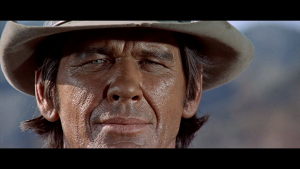OTF Reflection 4
Gilles Deleuze states that that ‘the out-of-field refers to what is neither seen nor understood, but is nevertheless perfectly present’ (Cinema 1: The Movement Image, pg. 16). Splitting the understanding of the frame into two layers based on this quote allows us to see how the world of the film influences each individual frame to build the narrative and the characters of the film. The first layer of the frame is what is in the reverse shot which builds up the viewer’s understanding of the space of the scene. During our tutorial, we watched the final shootout of the 1968 Sergio Leone spaghetti western film Once Upon a Time in the West which provides a clear example of the meaning behind the Deleuze quote. This scene is iconic in cinema history from the music, the staging, the acting calibre of Clint Eastwood who has become known for his many roles in Western films and the memorable desert landscape. For example, this close up of Jason Robards during the shootout ensures the audience is aware of what is out of the frame.
 Leone places this shot between wide shots and uses montage to establish the space the shootout will take place. The close up allows the audience to focus on Robards’ eyes as he watches his opponent move through the space. The use of montage informs the audience of is out of field which allows them to visualise what is happening in the reverse shot. The camera slowly moves around Robards’ face to mimic his opponent’s walk to aid this visualisation.
Leone places this shot between wide shots and uses montage to establish the space the shootout will take place. The close up allows the audience to focus on Robards’ eyes as he watches his opponent move through the space. The use of montage informs the audience of is out of field which allows them to visualise what is happening in the reverse shot. The camera slowly moves around Robards’ face to mimic his opponent’s walk to aid this visualisation.
References
Leone, Sergio (1968) Once Upon A Time In The West, Paramount Pictures
Leave a Reply